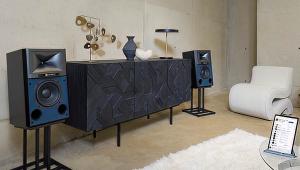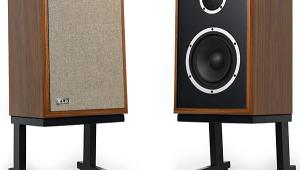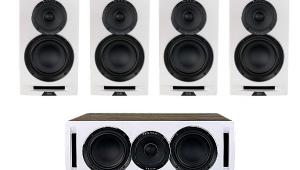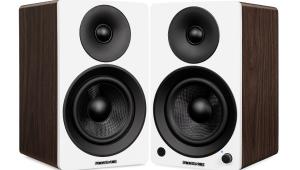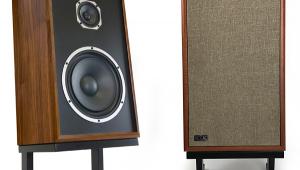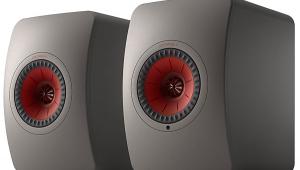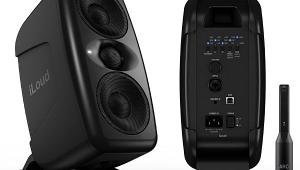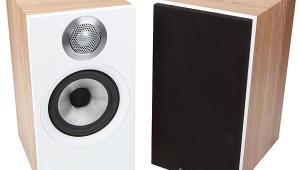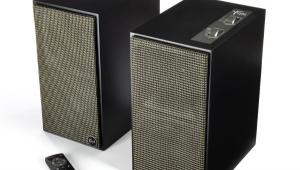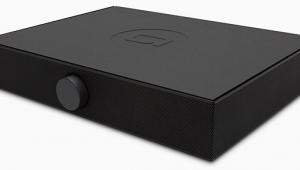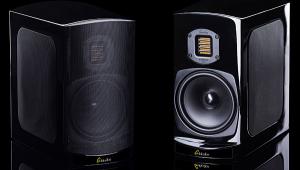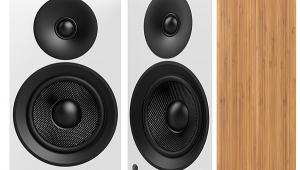Klipsch Quintet Speaker System Page 2
Transparency Trumps Resonance
The 5G Quintets won not just respect but admiration, and they did it swiftly. Only a few minutes had passed before I realized that they far outpaced previous generations in transparency and overall sound quality. I’m guessing the acoustically inert enclosures had a lot to do with this: Cabinet resonance, that boxy sound that bloats and muddies certain midbass or midrange frequencies, was conspicuous in its near-absence. But the surprises didn’t end there. Normally I’d expect horn-loaded drivers to be beamy—articulate, but speaker bound—yet these played against type. While objects between the speakers were imaged distinctly, ambience often lifted clear of the speakers, extending above and behind them, a trick only the best speakers can manage. On the downside, test tones during setup revealed a slight difference in dominant pitch between the satellites and center, though with normal program material the difference was negligible. There was more of a performance gap between the speakers, which were consistently brilliant; and the sub, consistently good but not outstanding.
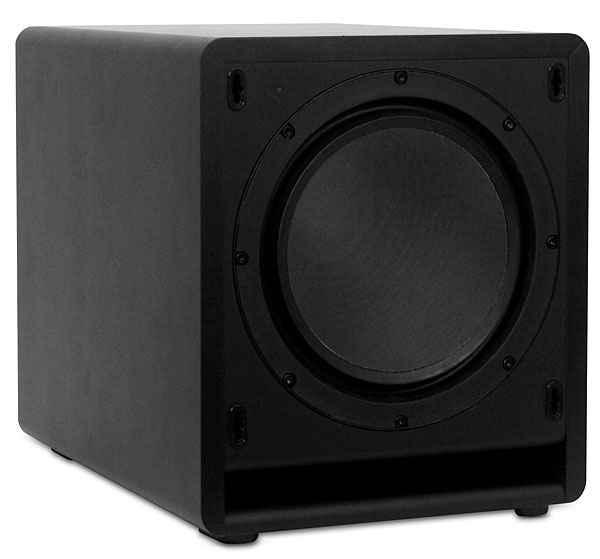
The satellites stood up to the onslaught of Skyfall (on Blu-ray Disc with DTS-HD Master Audio soundtrack) with good grace. The top end was smooth but not anesthetized. Integration of high and midrange frequencies was excellent, while the dovetailing between satellites and subwoofer was a little too obvious. The satellite’s and center’s IMG-coned woofers were better controlled than the sub’s fiberglass-coned driver, especially in the woofer-punishing extended underground train crash. The horn-loaded speakers easily displayed the soundtrack’s layering of elements, even at high volumes. Trajectories of effects were smooth and zingy in every conceivable direction—front to back, laterally, or diagonally—indicating a seamless soundfield. The best of the front-to-back effects was Javier Bardem’s memorable soliloquy, which included a decay that proceeded from front to rear at a deliciously stately pace.
Argo (BD, DTS-HD Master Audio) brought additional dynamic contrasts, notably between the tumultuous crowd noise in the opening scene and subsequent hushed dialogue. The Quintets had dynamic prowess to ace the loud, angry parts, combined with enough low-level resolution to make the muttering voices of fugitives fully intelligible. There was never a need to adjust volume to reconcile the two extremes. The Quintet held them both, as it were, in the palm of its stony hand.
In The Great Raid (DVD, Dolby Digital), the true story of a World War II POW camp rescue in the Philippines, both the voiceover and the execution chorus lifted clear of the speakers. A signal yearns to be free—of cabinet resonance—and the reinforced-polymer enclosures liberated it. Action scenes sharply punctuated by gunfire and bazookas were gripping and not wearing. The system successfully combined high output, detail, and listening comfort.
Shock and Awe
I’m one of the millions who bought Janis Joplin’s Pearl LP in the wake of her untimely death. Focusing on the blues-wailing voice—which seemed so raw and primordial, almost shocking, the first time I heard it—I became aware of the sweet spot in which the horn-loaded drivers did their best work. However, off-axis listening did not notably reduce the lead vocal’s vital prominence in the mix or distort its tonal signature. The Full Tilt Boogie band percolated more than it pounded, and the sub had no trouble keeping up with this modest task. This album was made to be played loud, and the Quintets got into the spirit of things, to the extent that their small metal tweeters allowed. Mushier and more forgiving speakers, like the paper-coned tombstones I bought in college, might have supported a more aggressive blare, but at the cost of other qualities—imaging and ambience—that I’ve come to value more.
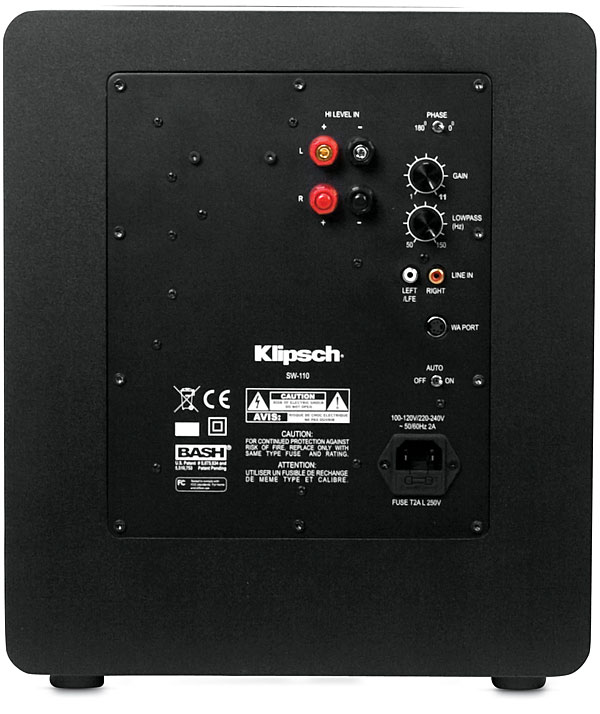
Robyn Hitchcock’s Love From London arrived on both LP and CD. His voice and Telecaster both have distinctive cutting edges that are blunted and gauzed with digital mixing tools on this album. High frequencies are rolled off in a very retro way, a bit like an analog audiocassette, yet utterly contemporary: Perhaps this is today’s way to make a play-it-loud album. The Quintets made the subtle distinction between the vinyl and digital versions. In neither case did they bring out more of the recessed presence region—which would have distorted the artist’s intent—though they did allow the vinyl to deliver a more even consistency.
Emanuel Ax’s Variations CD takes the form of a studio piano recital with Beethoven’s Eroica Variations, Haydn’s Variations in F Minor, and Schumann’s Symphonic Études. Since these satellites require a high crossover, using the pure audio mode for this selection and the preceding LPs was not an option. But even in 2.1-channel mode, with the subwoofer supplementing the satellites, the Quintets lost none of their capacity to surprise and mesmerize. The satellites were inspired jugglers, precisely reproducing the percussive effect of felted hammers hitting tightly stretched wires in a Yamaha concert grand while at the same time delivering the ambience of the recording venue with a big, open, liquid feel. The sub filled in the left-hand bass parts with the right quantity of bass output, though the quality and attack lagged behind, again making the sub localizable.
The fifth generation of the Klipsch Quintet lacks nothing but a roman numeral—we’d all be a lot less confused if the manufacturer would call it the Quintet V, as in fact some online retailers are doing already. I can count the number of equally fine compact satellites I’ve heard on the fingers of one hand, and as a specialist in the genre, I’ve heard quite a few. The Tractrix horn continues to deliver high output and solid imaging, its longtime strengths. However, in this new variation, the horn-loaded tweeters are more refined than ever at high volumes, and they seem to have acquired a new virtuosity in reproducing ambience, especially in the vertical plane, which pleasantly surprised me time and again. The SW-110 subwoofer is more conventional in both design and performance. But hey, this package sells for $1,050, probably less with street discounts. And because the products are sold separately—$550 for the satellites and $500 for the subwoofer—you’re free to mix and match. The new Quintet is both a marvel and a bargain.

